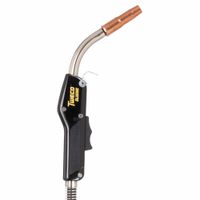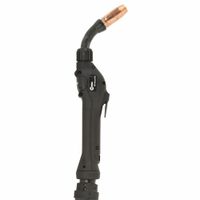Call +(254) 703 030 000 / 751 483 999 / 721 704 777
- Home
- Welding
- Arc Welding
- Mig Welding
- Mig Guns
.....Read More
Frequently Asked Questions
What is the difference between a MIG gun and a TIG torch?
A MIG (Metal Inert Gas) gun and a TIG (Tungsten Inert Gas) torch are both tools used in welding, but they differ significantly in their operation, applications, and components.
1. **Operation**:
- **MIG Gun**: Utilizes a continuous wire feed as an electrode and filler material, which is melted by an electric arc to join metals. The process is semi-automatic or automatic, making it faster and suitable for high-production environments.
- **TIG Torch**: Uses a non-consumable tungsten electrode to produce the weld. Filler material, if needed, is added manually. This process allows for greater precision and control, making it ideal for detailed work.
2. **Shielding Gas**:
- **MIG Gun**: Typically uses inert gases like argon or a mix of argon and CO2 to protect the weld pool from contamination.
- **TIG Torch**: Primarily uses pure argon or helium, providing a clean environment for the weld.
3. **Applications**:
- **MIG Gun**: Suitable for welding thicker materials and is commonly used in industries like automotive and construction. It is effective on a variety of metals, including steel, stainless steel, and aluminum.
- **TIG Torch**: Preferred for thinner materials and applications requiring high precision, such as aerospace and art. It is excellent for welding non-ferrous metals like aluminum and magnesium.
4. **Components**:
- **MIG Gun**: Includes a trigger, contact tip, nozzle, and a wire feed system.
- **TIG Torch**: Comprises a tungsten electrode, collet, collet body, gas cup, and a manual filler rod.
5. **Skill Level**:
- **MIG Gun**: Easier to learn, suitable for beginners.
- **TIG Torch**: Requires more skill and practice to master due to its manual nature.
How do I choose the right MIG gun for my welding needs?
To choose the right MIG gun for your welding needs, consider the following factors:
1. **Amperage Rating**: Match the gun's amperage rating with your welding machine and the thickness of the material. Higher amperage guns are needed for thicker materials.
2. **Duty Cycle**: Ensure the gun's duty cycle aligns with your welding frequency. A higher duty cycle is necessary for prolonged welding sessions.
3. **Wire Size Compatibility**: Select a gun that supports the wire size you plan to use. Different guns accommodate different wire diameters.
4. **Cooling Method**: Decide between air-cooled and water-cooled guns. Air-cooled guns are lighter and suitable for lower amperage, while water-cooled guns handle higher amperage and longer welding periods.
5. **Ergonomics**: Choose a gun with a comfortable grip and weight to reduce fatigue during extended use. Consider the handle design and trigger placement.
6. **Cable Length**: Ensure the cable length suits your workspace and allows for easy maneuverability without excessive tension.
7. **Consumables Availability**: Check the availability and cost of consumables like nozzles, contact tips, and liners for the gun model.
8. **Brand and Compatibility**: Opt for reputable brands that offer compatibility with your welding machine and easy access to replacement parts.
9. **Environment**: Consider the welding environment. For example, a flexible neck might be beneficial in tight spaces.
10. **Budget**: Balance cost with features. Higher-end guns offer better durability and performance but at a higher price.
By evaluating these factors, you can select a MIG gun that meets your specific welding requirements, ensuring efficiency and quality in your work.
What are the common problems with MIG guns and how can they be fixed?
Common problems with MIG guns include:
1. **Wire Feeding Issues**: This can be caused by incorrect tension settings, worn drive rolls, or a clogged liner. Fix by adjusting the tension, replacing worn parts, and cleaning or replacing the liner.
2. **Contact Tip Wear**: Excessive wear or burnback can lead to poor arc stability. Replace worn tips regularly and ensure proper tip-to-work distance.
3. **Overheating**: Overheating can result from exceeding the gun's duty cycle. Use a gun with a higher duty cycle or allow adequate cooling time.
4. **Gas Flow Problems**: Inadequate shielding gas can cause porosity. Check for leaks, ensure proper gas flow settings, and inspect the gas nozzle for obstructions.
5. **Spatter Build-up**: Excessive spatter can clog the nozzle and affect gas flow. Regularly clean the nozzle and use anti-spatter spray.
6. **Liner Issues**: A kinked or worn liner can cause wire feeding problems. Replace the liner if damaged and ensure it is properly trimmed and installed.
7. **Loose Connections**: Loose connections can lead to poor electrical conductivity. Regularly check and tighten all connections.
8. **Gun Positioning**: Incorrect gun angle or distance can affect weld quality. Maintain a consistent angle and distance as recommended for the material and joint type.
9. **Cable Wear**: Damaged cables can cause erratic arc behavior. Inspect and replace worn or damaged cables.
10. **Trigger Malfunction**: A faulty trigger can disrupt welding. Inspect and replace the trigger if necessary.
Regular maintenance and inspection can prevent many of these issues, ensuring optimal performance of the MIG gun.
How do I maintain and clean a MIG gun?
1. **Disconnect Power**: Ensure the welding machine is turned off and unplugged to prevent accidents.
2. **Inspect the Gun**: Regularly check for wear and damage on the nozzle, contact tip, and liner. Replace any worn or damaged parts.
3. **Clean the Nozzle**: Remove the nozzle and clean it with a wire brush or nozzle cleaning tool to remove spatter. Use anti-spatter spray to prevent future buildup.
4. **Check the Contact Tip**: Remove the contact tip and clean it. Ensure the hole is not enlarged or oval-shaped, as this can affect performance. Replace if necessary.
5. **Examine the Liner**: Check the liner for blockages or kinks. Blow compressed air through it to remove debris. Replace if worn or damaged.
6. **Inspect the Diffuser**: Ensure the gas diffuser is clean and free of spatter. Replace if it shows signs of wear.
7. **Check the O-rings**: Inspect O-rings for cracks or wear and replace if needed to maintain a proper seal.
8. **Inspect the Cable**: Check the cable for cuts, burns, or other damage. Ensure connections are tight and secure.
9. **Reassemble the Gun**: Once all parts are cleaned and inspected, reassemble the gun carefully, ensuring all components are properly aligned and secured.
10. **Test the Gun**: After maintenance, test the gun on a scrap piece of metal to ensure it is functioning correctly.
11. **Regular Maintenance Schedule**: Establish a routine maintenance schedule based on usage to keep the MIG gun in optimal condition.
12. **Proper Storage**: Store the MIG gun in a clean, dry place to prevent damage and contamination.
What is the role of shielding gas in MIG welding?
The role of shielding gas in Metal Inert Gas (MIG) welding is crucial for ensuring high-quality welds. Shielding gas serves several key functions:
1. **Protection from Contamination**: The primary role of shielding gas is to protect the molten weld pool from atmospheric contamination. Oxygen, nitrogen, and hydrogen in the air can cause defects like porosity, oxidation, and embrittlement in the weld. The shielding gas creates a protective barrier around the weld area, preventing these gases from coming into contact with the molten metal.
2. **Arc Stability**: Shielding gas helps stabilize the welding arc. A stable arc is essential for consistent heat input and smooth metal transfer, which in turn leads to a uniform weld bead. Different gases or gas mixtures can influence the arc characteristics, affecting penetration and bead shape.
3. **Metal Transfer**: The type of shielding gas can affect the mode of metal transfer in MIG welding. For instance, argon-rich gases promote a smooth, spray transfer, while carbon dioxide can lead to a more turbulent, globular transfer. The choice of gas impacts the weld's appearance and mechanical properties.
4. **Heat Input Control**: Shielding gases can influence the heat input to the workpiece. For example, argon provides a cooler arc compared to carbon dioxide, which can be beneficial for welding thin materials or reducing distortion.
5. **Weld Appearance and Quality**: The right shielding gas can improve the overall appearance of the weld, reducing spatter and resulting in a cleaner finish. It also contributes to the mechanical properties of the weld, such as strength and ductility.
Common shielding gases include argon, carbon dioxide, and mixtures like argon/CO2 or argon/helium, each chosen based on the material being welded and the desired weld characteristics.
How do push-pull guns and spool guns differ in handling aluminum wire?
Push-pull guns and spool guns are both used for feeding aluminum wire in welding, but they differ in their handling and performance.
Push-pull guns have a motor in both the welder and the gun, which work together to push and pull the wire through the liner. This dual-drive system reduces the risk of wire tangling or bird-nesting, which is common with soft aluminum wire. Push-pull guns allow for longer cable lengths, providing greater flexibility and reach. They offer consistent wire feeding, which is crucial for maintaining weld quality, especially in industrial applications. However, they are generally more expensive and require more maintenance due to their complex design.
Spool guns, on the other hand, have a small spool of wire mounted directly on the gun. This design minimizes the distance the wire travels, reducing the chance of tangling. Spool guns are simpler and more cost-effective, making them suitable for smaller projects or less frequent use. They are easier to set up and maintain, but the limited spool size means more frequent spool changes, which can interrupt workflow. Spool guns are typically heavier and can be cumbersome for extended use, and they are limited in cable length, restricting mobility.
In summary, push-pull guns are ideal for professional settings requiring high-quality, consistent welds over longer distances, while spool guns are better suited for smaller, less demanding projects where cost and simplicity are priorities.
What are the advantages of using a water-cooled MIG gun over an air-cooled one?
Water-cooled MIG guns offer several advantages over air-cooled ones:
1. **Higher Amperage Capacity**: Water-cooled guns can handle higher amperage levels, typically up to 600 amps, compared to air-cooled guns, which are usually limited to around 300-400 amps. This makes them suitable for heavy-duty industrial applications.
2. **Reduced Overheating**: The water-cooling system efficiently dissipates heat, reducing the risk of overheating. This allows for longer continuous welding periods without the need for frequent breaks to cool down, increasing productivity.
3. **Lighter Weight**: Water-cooled guns are generally lighter than air-cooled ones because they require less copper and aluminum for heat dissipation. This reduces operator fatigue and improves maneuverability, especially in complex welding positions.
4. **Improved Weld Quality**: Consistent cooling helps maintain a stable arc and reduces spatter, leading to better weld quality. It also minimizes the risk of distortion and warping in the workpiece.
5. **Extended Consumable Life**: The efficient cooling extends the life of consumables such as contact tips and nozzles by reducing thermal stress and wear, leading to cost savings over time.
6. **Versatility**: Water-cooled guns are versatile and can be used for a wide range of materials and thicknesses, making them ideal for diverse welding applications.
7. **Reduced Downtime**: With less frequent need for cooling breaks and consumable changes, water-cooled systems contribute to reduced downtime and increased operational efficiency.
8. **Enhanced Safety**: Lower surface temperatures reduce the risk of burns and improve safety for operators.
Overall, water-cooled MIG guns are ideal for high-volume, high-amperage welding tasks where efficiency, quality, and operator comfort are priorities.


